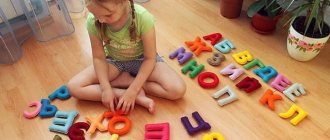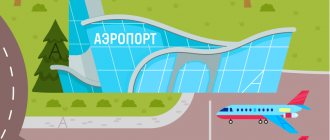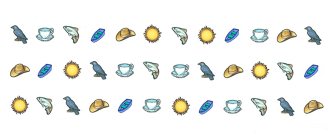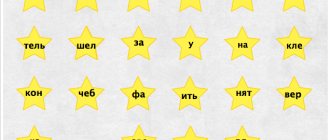Before learning to read, a child must learn the very concept of syllables. Before learning to read and write, your child must recognize letters and be able to relate them to sounds. The next stage is learning syllables. Interesting manuals for studying syllables can be downloaded from our website.
Is it difficult to teach a child to combine letters into syllables?
How to learn to read?
At the beginning of learning to read, it is necessary to convey to the child such concepts as vowel and consonant sounds and letters. Vowel sounds can be stressed or unstressed. Among the consonants, there are voiced and voiceless, hard and soft.
By the way, special attention should be paid to the hardness and softness of sounds. This characteristic of sounds within a syllable is determined by soft or hard signs or vowels located after consonants.
So, the letters E, E, I, Yu, I indicate the softness of the previous consonant sound, and the letters E, O, U, Y indicate hardness.
A table of all syllables on our website will help illustrate soft and hard consonant sounds. It can be read online or downloaded and printed from our website.
Syllables for children to learn to read can be presented in the form of a game. To teach your child to read, you need to download a table of syllables and print it. Then cut into individual cards. To prevent syllables and cards from becoming wrinkled, they can be glued onto thick cardboard. Now we will try to introduce syllable combinations to children in the form of a game.
Reading speed standards for grades 1-4 (words per minute)
Interesting fact! According to the Guinness Book of Records for 1990, Howard Berg was declared the fastest reader in the world, who announced a result of 25,000 words per minute. Outwardly, such reading should look like ordinary page turning. But doubts arose about the reliability of this record back in the 1990s, and as a result, Howard was banned from advertising his speed reading courses.
More realistic data was obtained by Ronald Carver, a professor at the University of Missouri in Kansas City, who studied speed reading in the 1980s. For testing, he invited the winners of specialized competitions, editors of magazines and newspapers - in short, people who can quickly work with texts. But in the end it turned out that when understanding the text at least 75%, none of the participants was able to overcome the barrier of 600 words/min. Yes, this result is much above average, but it is very far from the record. This is probably what you should expect when mastering speed reading techniques.
Games for learning to read
A table of all syllables, which you will need to download from our website, will help you teach your child to read. Soft and hard consonants, as well as vowel sounds and letters are indicated in different colors for contrast. Thus, syllable combinations look bright and colorful.
First, we teach the child to distinguish syllables in Russian from each other. To do this, you will need not only cards where the syllables of the language to be read are written, but also a whole table of syllables. To do this, you will have to download and print it again. We lay out the table and ask the child to match the cards with syllables and the corresponding cell in the table. So gradually the baby will remember individual syllable combinations and name them, and then read them. Thus, we form a lotto from a table, only instead of images there are letter combinations.
At the next stage of learning to read, we offer the child a couple of different syllables and combine them into a word. Please note that before starting this game, the child must read individual syllable combinations well and then put them into words. For example, we take the syllable ZHA and add the syllable BA to it. It turns out to be a TOAD. You can draw arrows or come up with a fairy-tale character who will walk from one syllable to another and connect them into words. As a result of such a simple game, the child will quickly learn to read.
For children over 8 years old
Continue improving your reading speed in second grade. Eight-year-old children are independent and fast. They have outgrown the first grade activities, so offer them other fun exercises and games:
Looking for a word, line
The meaning of the game: a schoolchild (2nd grade) finds all the words in the text that begin with the same letter. Searching for a whole phrase is a more complicated version of the task.
The exercise teaches attentiveness and develops the left hemisphere of the brain - the linguistic one.
Insert letters
A second grader is presented with a text with missing letters. To read it and understand it, you need to think of endings and prefixes. This speeds up the pace of text comprehension in the future and helps to combine letters into whole words.
Fixing the error
The teacher reads the text, the children follow. The teacher deliberately makes a mistake in the ending of a word, root, etc. The task of a 2nd grade student is to correct the inaccuracy.
Read at speed
A second-grader independently takes measurements of reading technique, timing a minute, and keeps a diary of successes. Normally, by the second grade, children read at least 70 words, in the third - 100 words, in the fourth - 120.
Playing "Hidden Words"
The game is similar to reading anagrams. Children find words (large and small) in the field with letters. It looks like this:
Words can be selected on one topic or randomly. It is better for primary school students to provide a list of words that need to be found, leaving the task of isolating them on the field.
And one more option that you can print and use with your child.
Reading and counting
A second grader reads the text and counts the given sounds. For example, in the following poem, find out the number of “o” sounds.
The ball is bouncing along the path,
We can't catch the fast ball.
Develops multitasking skills and concentration.
Syllable tables
Since letter combinations are represented in large numbers in the Russian language, we suggest studying each consonant separately in combination with all vowels. Thus, the table for one game becomes much smaller in volume, and it is easier for the child to put all the syllables in their places. You can also download these tables on our website. Here are examples of what syllables might look like for your kids in tables:
Special exercises
Expanding the field of view
- Shulge table.
Necessary to increase the viewing angle. For second graders, use this version of the table:
The child looks for numbers in order with his eyes: from 1 to 25, for example, only black or only red. Record your time and limit it gradually. Searching for numbers in the table will increase the rate of speech, since the student will see more words with peripheral vision, that is, subconsciously read them in advance.
- Wedge tables.
The student needs to concentrate his gaze on the top numbers, gradually moving down. The numbers are spoken out loud. After several exercises using a wedge-shaped table, the student will see all the signs on the left and right at the same time. Download teaching materials from letters and numbers on the Internet.
Regression Suppression
Returning your gaze to a line you’ve already read – regression – greatly slows down the pace of reading. To get rid of the unwanted effect, use the following training exercises:
- Indicate the reading direction.
Take a pointer or pencil and move it forward along the lines. The child intuitively follows the pointer without looking back.
- Close the text you read.
Prepare a special bookmark for the student.
Have the second grader place it at the top of the text, gradually moving it down as they read. This way the read passage will be hidden from view. It is impossible to return to him.
- Check your speed constantly.
Measure your reading technique every day. To improve your results, you will always have to move forward without looking back.
Articulation suppression
Younger schoolchildren often cannot read to themselves without pronouncing words with their lips, even silently. This is unacceptable for speed reading. Articulation must be suppressed. The technique of sliding the eyes over the text is trained as follows:
- musical accompaniment;
We read to music without words, then with a song on. Pay attention to understanding the meaning of the text.
- "Bumblebee";
Ask students to hum while reading. This is a complex but effective method.
- rhythm;
Read and drum with your fingers and pencil on the table. Gradually increase the pace.
- lock;
Press your lips tightly and cover your mouth with your palm. We read to ourselves at the highest possible speed.
Important! After reading, ask the student questions about the text to check their reading comprehension.
Exercises to correct attention and concentration
Without a high level of attention, it is impossible to read quickly and at the same time understand what the text is about and highlight the main thing. To adjust your attention and concentration, do the following exercises:
- We make up words.
Take a long word. For example, "representation". Short words are made from it: “forest”, “shaft”, “toast”, “harm” and others.
- Finding differences.
In pairs: “horse - laziness”, “sleep - tone”, “kitty - fox”, differences are looked for. It is necessary to explain in detail how they are similar and different.
- Changing fonts.
Type texts on your PC in different fonts. If desired, they can be printed. Invite your child to read. It is necessary to gradually increase the speed of reading such texts so that attention is not focused on the size and type of font.
- We confuse words.
Write sentences on a piece of paper with the words rearranged in the wrong order: “the bull walks, sighs, sways.” The challenge is to find a place for each word.
- Let's note the main thing.
After reading the text, you need to highlight controversial points with a pencil and highlight the main ideas.
- We include both hemispheres in the work.
We read with the left and right eyes alternately. Use this technique as homework and a warm-up in class.
- Let's make riddles.
Trick questions and tricky riddles develop attention well.
- Let's name the colors.
Use a field like this:
Task: without reading the word, name the color with which the letters are painted.
The Development of Ancipation
This skill is well developed in adults. Guessing a word based on the meaning of the text, without seeing the end of the sentence, develops when performing the following tasks:
- text upside down;
First, the text is read in normal form, then turned 90° or upside down. It is being worked on.
- ruler;
Place a wide ruler on the sides of the text. The beginning and end of the sentence will not be visible. The child will have to guess what words are written there according to their meaning.
- halves;
Now use a ruler to close the upper halves of the letters on one line. The child is reading.
Memory training
- visual dictation;
The child is given a text to read. Then all phrases except the first sentence are hidden from view. 7-8 seconds are allotted for memorization, the child writes down from memory. In this way, the text is completely processed step by step.
- chain;
We read words on one topic. For example, forest - tree - pine cone - bear, etc. The student listens and reproduces the chain orally and in writing. You need to start with three to five words, gradually increasing to ten to twelve.
- word repair;
The child is given a text with missing letters. They need to be guessed while reading. The advantage of the method: the student keeps the meaning of the text in his head and expands his vocabulary.
Reading with an adult
Imposing reading speed is an effective teaching technique. Use the following cooperative task systems:
- reading simultaneously with a parent;
The adult reads aloud, the child reads to himself. The speed is constantly changing. The student's task: not to get lost.
- relay race;
The adult and the child constantly change roles. First one reads, the other follows, then vice versa.
- tail;
The teacher reads the text first, the student picks up a little later, three or four words behind. Parallel playback out loud has a disadvantage: the voices interfere with each other. You need to read in a whisper or in a low voice.
Common mistakes
Often in speech, children confuse syllables with the letters “x”, “g” and syllables with the letters “g”, “k”. Confusion also occurs when a child pronounces syllables with the letter “d”, “g” or syllables with the letter “k”, “p”. These consonants sound very similar. When making words from them, try to pronounce them as clearly as possible. At the stage of learning to read, you can download tables with similar sounds, cut cards from them and try to create words that sound similar, focusing on the difference in spelling.
When studying Russian letter combinations with children, try to interest them. If you have a magnetic alphabet at home, try to form some words from the letters. They can be conveniently attached to your tablet and then read. Let the child make up his own word combinations and you read them.
Word creation should be a group game: one child will not be interested. Teach your baby and learn with him!
From what age can it be used?
Teachers recommend starting to read no earlier than 5 years of age.
The effectiveness of learning largely depends on the child’s development; at the time of learning, he must have the following skills:
- pronounce all letters;
- be able to retell a short story;
Before starting education, you should determine the child’s readiness for reading and school in general.
- have developed auditory memory, in accordance with age, for example, at 4 years old a child should remember 4 words, at 5 years old - 5 words;
- the child remembers simple quatrains.
In general, everything is individual; tables are classified as tools of visual perception. Such material is not always used in schools, so it is better to use the technique in preschool age to avoid confusion.







